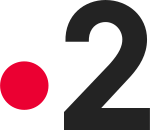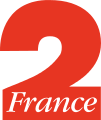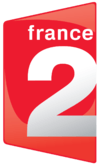France 2
France 2 (pronounced [fʁɑ̃s dø]) is a French public national television channel. It is part of the state-owned France Télévisions group, along with France 3, France 4, France 5 and France Ô. France Télévisions also participates in ARTE and EuroNews.
| France 2 | |
|---|---|
 | |
| Launched | 18 April 1964 |
| Owned by | France Télévisions |
| Picture format | 1080i HDTV (downscaled to 16:9 576i for the SDTV feed) |
| Audience share | 12.8% (October 2018, Médiamétrie) |
| Slogan | Nos différences nous rassemblent. |
| Country | France |
| Broadcast area | Europe, Middle East, Africa, Americas and Australia |
| Formerly called | La deuxième chaîne de la RTF (1964) La deuxième chaîne de l’ORTF (1964 – 1975) Antenne 2 (1975 – 1992) |
| Sister channel(s) | France 3 France 4 France 5 France Ô |
| Website | www |
Availability | |
| Terrestrial | |
| TNT | Channel 2 (HD) |
| TNT in Overseas France | Channel 2 or 3 or 4 |
| Satellite | |
| Canal+ | Channel 2 |
| TNTSAT Fransat | Channel 2 |
| TéléSAT | Channel 11 |
| Canal+ Réunion / Calédonie / Caraïbes | Channel 12 |
| Platforma Canal+ | Channel 232 |
| TV Vlaanderen | Channel 63 |
| Meo (Portugal) | Channel 256 |
| Canal+ Afrique | Channel 52 |
| StarTimes | Channel 641 |
| Cable | |
| Ziggo (Netherlands) | TV Française Ziggo App Channel 3 (HD) |
| Vodafone (Germany) | Channel 685 |
| Unitymedia (Germany) | Channel 18 (SD) |
| Caiway (Netherlands) | Channel 224 (SD) |
| DELTA (Netherlands) | Channel 501 (SD) |
| Telenet (Belgium) | Channel 25 (Wallonia & Brussels) Channel 151 (Flanders) |
| VOO (Belgium) | Channel 8 |
| SFR (Luxembourg) | Channel 41 |
| UPC Switzerland | Channel 4 (Romandy) Channel 304 (Deutschswizz) Channel 504 (Ticino) |
| IPTV | |
| French TV providers | Channel 2 |
| KPN (Netherlands) | Channel 92 (HD) |
| Proximus TV | Channel 7 (Wallonia & Brussels) Channel 257 (Flanders) |
| Scarlet | Channel 46 |
| Sunrise | Channel 4 |
| FL1 (Liechtenstein) | Channel 143 |
| My.t | Channel 140 |
Since 3:20 CET on 7 April 2008, all France 2 programming has been broadcast in 16:9 widescreen format[1] over the French analogue and digital terrestrial television. An HD simulcast feed of France 2 has been broadcasting on satellite provider CanalSat since 1 July 2008 and on digital terrestrial television since 30 October 2008.[2]
History
Originally under the ownership of the RTF, the channel went on the air for the first time on 18 April 1964 as RTF Télévision 2. Within a year, ORTF rebranded that channel as La deuxième chaîne (The Second Channel). Originally, the network was broadcast on 625-line transmitters only in preparation for the discontinuation of 819-line black & white transmissions and the introduction of colour. The switch to colour occurred at 14:15 CET on 1 October 1967, using the SECAM system. La deuxième chaîne became the first colour television channel in France although TF1 would not commence colour broadcasting on 625-lines until 1 September 1975. Such technology later allowed the network to air programming in NICAM stereo (compatible with SECAM).
The present channel is the direct successor of Antenne 2, established under a 1974 law that mandated the breakup of ORTF into seven distinct organisations. Three television "programme corporations" were established on 6 January 1975 – TF1, Antenne 2 and FR3, now France 3 – alongside Radio France, the Société française de production, the public broadcasting agency Télédiffusion de France and the Institut national de l'audiovisuel (INA). Antenne 2 and the other corporations were constituted as limited companies with the state controlling 100% of their capital. Although the three channels were set up as competitors vying for advertisers, they retained a collective monopoly over television broadcasting in France that was not repealed until 1981. Privately owned channels such as Canal+ and La Cinq (now superseded by France 5) soon became major competitors to the state-owned channels after the state monopoly was lifted.[3] The breakup of ORTF had been intended to stimulate competition between the public channels but failed in this aim; both TF1 and Antenne 2 came to rely on a diet of popular entertainment shows alongside cheap American imports, seeking to maximise ratings and attract advertisers.[4]
TF1 was privatised in 1987, radically affecting the balance of the French television market. The remaining state-owned channels came under severe pressure from their private competitors and lost 30% of their market share between 1987 and 1989.[5] In an effort to save them, a single director-general was appointed to manage both Antenne 2 and FR3 and the two channels merged to form the France Télévisions group. They were renamed on 7 September 1992 as France 2 and France 3 respectively.[6]
By 1995, the combined audience share of the two state-owned channels was 41%, with France 2 in particular being heavily dependent on advertising and sponsorship revenues, which comprised 43.8% of its budget by 1996. The focus on ratings led to strong rivalry with TF1, for instance prompting the two channels to broadcast popular shows and news programmes in the same timeslots. TF1 and France 2 compete for the same demographics; dramas (including American imports), game shows and light entertainments form the dominant mix on both channels.[7]
Logos
.svg.png) Logo of Antenne 2 (1982-1986; logo remained in use for startup/closedown montage until 1990)
Logo of Antenne 2 (1982-1986; logo remained in use for startup/closedown montage until 1990) Logo of France 2 from 7 September 1992 till 7 January 2002
Logo of France 2 from 7 September 1992 till 7 January 2002 Logo of France 2 from 7 January 2002 till 7 April 2008
Logo of France 2 from 7 January 2002 till 7 April 2008 Logo of France 2 from 7 April 2008 till 29 January 2018
Logo of France 2 from 7 April 2008 till 29 January 2018 Logo of France 2 from 29 January 2018
Logo of France 2 from 29 January 2018
Leaders of France 2
- General President-Director
- Since 7 September 1992, the position of general President-Director of France 2 has governed over both France 2 and France Télévision.
- General Directors
- Georges Vanderchmitt (September 1992 – January 1994)
- Raphaël Hadas-Lebel (January 1994 – June 1996)
- Michel Pappalardo (June 1996 – June 1999)
- Michèle Cotta (June 1999 – June 2002)
- Christopher Baldelli (June 2002 – September 2005)
- Philippe Baudillon (September 2005 – December 2007)
- François Guilbeau (December 2007 – August 2010)
- Claude-Yves Robin (August 2010 – 2 October 2011)
- Bertrand Mosca (3 October 2011 – 2 April 2012)
- Jean Réveillon (since 2 April 2012)[8]
- Program Directors
- Jean-Pierre Cottet (14 June 1996 – 20 July 1998)
- Patrice Duhamel (20 July 1998 – ?)
- François Tron (July 2001 – 1 October 2004)
- Yves Bigot (1 October 2004 – 1 September 2005)
- Jean-Baptiste Jouy (1st Septembre 2005 – 20 January 2007)
- Éric Stemmelen (20 January 2007 – 1 July 2009)
- Alain Vautier (1 July 2009 – 14 September 2011)
- Perrine Fontaine (2008 – 28 September 2012)[9]
- Philippe Vilamitjana (2 April 2012 – 21 October 2013)
- Thierry Thuillier (since 21 October 2013)[10]
- Information Directors
- Jean-Luc Mano (December 1993 – June 1996)
- Pierre-Henri Arnstam (June 1996 – September 2000)
- Gérard Leclerc (September 2000 – July 2001)
- Olivier Mazerolle (July 2001 – March 2004)
- Arlette Chabot (March 2004 – 19 August 2010)
- Thierry Thuillier (20 August 2010 – 21 October 2013)[11]
- Yannick Letranchant (Since 21 October 2013)
- Writing Directors
- Éric Monier (since ?)
- Sports Directors
- Jean Réveillon (1992 – 1998)
- Patrick Chêne (1999 – 2000)
- Charles Biétry (2000 – 2001)
- Frédéric Chevit (2001 – 2005)
- Daniel Bilalian (Since March 2005)
Programming
Italian coverage
From 1975, Antenne 2 was available in Italy (regions of Tuscany, Lazio, Lower Veneto and parts of Lombardy and Liguria) using SECAM and since 1983 using PAL until 2003 when the frequencies were sold to various television networks like such as Canale Italia and Gruppo Editoriale L'Espresso.
Since 11 December 2006, France 2 was again made available across Italy on Digital terrestrial television until 7 June 2007, when it was replaced by all-news French TV network France 24.
France 2 is now only available in Aosta Valley due to Italian self-government laws, and in the border zones because of natural spillover.
Controversy
Lebanese Civil War kidnapping of Antenne 2 news team
In March 1986, an Antenne 2 news team was kidnapped in Beirut while reporting on the Lebanese Civil War. Philippe Rochot, Georges Hansen, Aurel Cornéa and Jean-Louis Normandin were four of many Western hostages held by terrorists during the conflict. During the opening sequences of Antenne 2 news bulletins, the headlines would be followed by a reminder of the French hostages held in Lebanon, including others such as Michel Seurat and Jean-Paul Kaufman, with names, photos and the length of their captivity. Within a year, most of the news team had been released and returned to France, but the reminders continued until all the hostages had been freed.
Muhammad al-Durrah shooting
On 30 September 2000, France 2 aired the famous footage of the shooting of Muhammad al-Durrah in the Gaza Strip. The scene was filmed by a Palestinian journalist, Talal Abu Rahma, who worked for the station.[12] The voiceover, blaming the killing on fire from the Israeli Defence Forces, was provided by the channel's reporter Charles Enderlin. Subsequently, that account was put in doubt, with others suggesting that the fatal shots could not have come from the IDF position.[13] France 2 later launched libel actions against commentators who alleged that the incident was staged. France 2 won a case against one of those critics, Philippe Karsenty who was eventually and definitely fined €7,000 by the Court of Appeal of Paris in 2013.[14] Karsenty had been convicted in 2006, acquitted in appeal in 2008,[15] which decision was cancelled in 2012 by the Cour de cassation.
2008–2009 Israel-Gaza Conflict
France 2 has been accused of airing misleading footage of the event that was biased against Israel during the 2008–2009 Gaza conflict.[16] It aired portion of a video that purported to show destruction caused by the Israel Air Force in January 2009, but was shown to be a different incident from 2005 in which the IDF denied having any involvement.[17][18] After being alerted to the error by bloggers,[19] France 2 acknowledged the error and formally apologized in the magazine Le Figaro, saying that it was an "internal malfunction" caused by their staff having "worked too fast."[16][20][21]
2013 report on weapons smuggling from Serbia to France
France 2 has been accused of knowingly producing and airing a news item whose key part it fabricated and staged.
On 7 March 2013, France 2 aired an eight-minute investigative report purporting to expose a weapons smuggling channel from Serbia to France. The report authors, journalists Franck Genauzeau and Régis Mathé, traveled to Serbia in February 2013 where they filmed a story claiming that Serbia is a hub for international weapons smuggling. Among its footage, the report showed two masked men – identified as Serbian weapons smugglers – who talked about their supposed illegal activity while showing off some of the weaponry: in particular two hand guns and one AK-47 Kalashnikov. They're also shown firing off rounds in the woods.[22]
After the report aired, the Serbian police's criminal department (UKP) conducted a month-long investigation, revealing its findings in May 2013 that parts of the French news story were staged with full knowledge of the two France 2 journalists.[23]
According to the police report, Genauzeau and Mathé arrived in Belgrade where they hired a local media fixer named Aleksandar M. who was employed at a Serbian news agency, giving him the task of finding weapons smugglers willing to go before a camera. Aleksandar M. apparently contacted his cousin Nenad Mirković and told him that the French were willing to pay €800 for weapons smugglers. At this point Mirković decided that he himself will appear on camera and also contacted his friend Žarko Blagojević to do the same. In order to make their act more credible, they then obtained two handguns – Zastava 9mm and 7.56mm – from Blagojević's father-in-law and father respectively. They also decided to get an automatic weapon by buying it from certain Milorad Novaković, a resident of Umka. Apparently, the two first offered him €200, but Novaković wanted €350, at which point they went back to two French journalists asking for more money and getting it.
Coached by Genauzeau and Mathé, the footage featuring masked Blagojević and Mirković was shot at a house owned by Blagojević's friend in Umka. Afterwards, they went into the nearby woods in Duboko near Umka where they fired off a few rounds for the cameras. They then returned the two handguns to Blagojević's father and father in law before selling the Kalashnikov for €100. According to the Serbian police report, Aleksandar M. was paid €300 by the French journalists while Mirković and Blagojević split the €800 between themselves.
Serbian foreign minister Ivan Mrkić reacted to the police report by "seeking explanations from France as the ministry looks to make sure the untruths from the report are clarified".[24]
References
- France 2 goes 16:9 widescreen : Broadband TV News
- France 2 HD launches on CanalSat : Broadband TV News
- Rigourd, Serge. "France", in Western Broadcasting at the Dawn of the 21st Century, pp. 255, 270. Eds. Haenens, Leen; Saeys, Frieda. Walter de Gruyter, 2001. ISBN 3-11-017386-7
- Looseley, David. Popular Music in Contemporary France: Authenticity, Politics, Debate, p. 122. Berg Publishers, 2003. ISBN 1-85973-636-X
- Rollet, Brigitte. "Television in France", in Television in Europe, pp. 39–40. Eds. Coleman, James A.; Rollet, Brigitte. Intellect Books, 1997. ISBN 1-871516-92-7
- Hart, Jeffrey A. Technology, Television, and Competition: The Politics of Digital TV, p. 46. Cambridge University Press, 2004. ISBN 0-521-82624-1
- Scriven, Michael; Lecomte, Monia. Television Broadcasting in Contemporary France and Britain, p. 46, 51. Berghahn Books, 1999. ISBN 1-57181-754-9
- « Jean Réveillon, directeur de France 2 », Le Figaro, 2 avril 2012.
- « La directrice des programmes de France 2 écartée », Le Figaro, 28 septembre 2012.
- "Officiel: Thierry Thuillier, directeur de l'info, devient le nouveau patron de France 2". jeanmarcmorandini.com (in French). Retrieved 24 October 2013.
- Direction commune des rédactions de France 2 et France 3 national.
- The Rory Peck Trust: Awards 2001 Archived 17 March 2008 at the Wayback Machine
- Who Shot Mohammed al-Dura?
- "Media analyst convicted over France-2 Palestinian boy footage", Associated Press, 26 June 2013.
- French court cancels libel in Intifada video case Reuters.
- Critics Say French TV Network Broadcast Fabricated Footage in Gaza, Again Fox News, 12 January 2009
- France 2 victime d'une intox palestinienne ?
- France 2 Uses Fake Gaza Video Israel National News 7 January 2009
- Gaza propaganda war escalates on the internet
- Gaza – France 2 : "une erreur bête" (Arlette Chabot)
- French network apologizes for Gaza report
- Sur la piste des trafiquants de kalachnikovs, de la Serbie à la France;France 2, 8 March 2013
- Nameštena reportaža: Francuska nacionalna televizija izmislila da je Srbija centar šverca oružja;Blic, 26 May 2013
- French national TV fabricates story about weapons smuggling;B92, 27 May 2013
External links
- Official website (in French)
- France Télévisions Corporate site (in French)